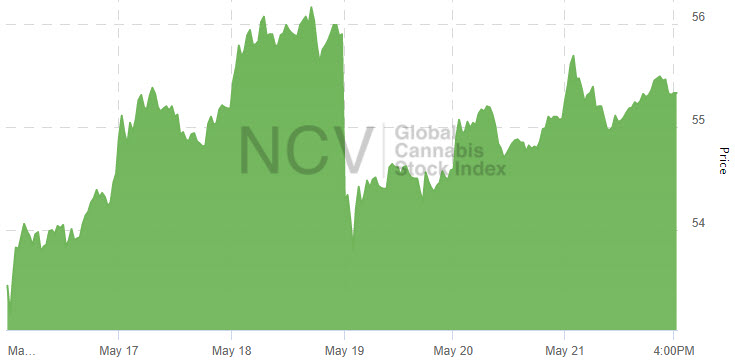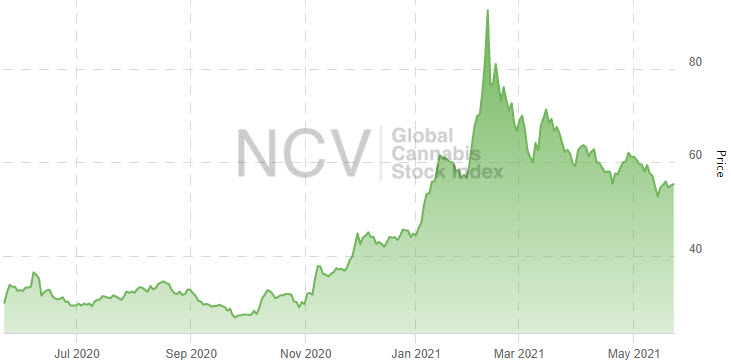Navigate the fast-moving cannabis sector with 420 Investor, a premium service that sends real-time alerts and explanations of the news below and much more.
Summary
- Mississippi’s medical cannabis referendum win was overturned, but Alabama approved medical cannabis and Minnesota expanded its program to include flower.
- Canadian cannabis sales grew 65% in March compared to a year ago, the slowest growth rate to date.
- Health Canada added 9 licenses, leaving the total now at 674.
- 420 Investor model portfolios have gained 45.9-71.1% year-to-date, while the Global Cannabis Stock Index has gained 24.6%.
Review
Alabama legalized medical cannabis legislation. Minnesota approved flower for its medical program. The Mississippi Supreme Court overturned the ballot referendum from November that had legalized medical cannabis in the state. The DEA has begun to issue research licenses, ending the monopoly held by Ole Miss.
Canadian retail cannabis sales hit a record in March, but the year-over-year growth at 65% was the slowest to date. Q1 sales were up less than 2% compared to Q4. Health Canada added 9 licenses, leaving the total at 674, including 2 that are expired, revoked or suspended.
During the week, I shared these insights with subscribers at 420 Investor:
- Previews for Cresco Labs, Planet 13 and TILT Holdings Financial Reports
- Large Canadian LP Implosion Creates Opportunities in Ancillary Names
- Previews for Alcanna, Greenlane, TerrAscend and The Parent Company
- Sub-Sector Review – 05/14/21
- Model Portfolio Composition 05/14/21
Here are some of this week’s highlights for 420 Investor Focus List names:
- ACB renewed an agreement with Grow Group that allows it to access the UK market. It announced a $300 million at-the-market equity program.
- CCHWF reported revenue of $92.5 million, including its Ohio operations that can’t yet be consolidated, up 220%, with adjusted EBITDA of $10.4 million. It also won a court battle in Illinois that will permit it to operate a cultivation facility
- CGC named Martha Stewart as the company’s official strategic advisor
- CURLF announced the pending acquisition of Colorado-based Los Sueños, an outdoor cultivator.
- FFLWF opened its first two BC stores in Vancouver
- GNLN Q1 revenue of $34 million was flat compared to Q4 and up slightly from a year ago, missing expectations, with adjusted EBITDA of -$5.2 million.
- GRAMF is investing $50 million into Glass House, getting a supply agreement of greenhouse-grown product and also a retail agreement for Glass House to carry its products. The company reported revenue of $39.9 million, with adjusted EBITDA of -$11.4 million. The company retracted previously provided guidance for 2021 and 2022, citing delays and asset dispositions. It also announced the departure of its Chief M&A Officer.
- GRWG COO Tony Sullivan sold $5 million of stock
- LQSIF reported slightly higher liquor revenue at $123.8 million, with its Nova Cannabis operations generating revenue of C$18.4 million, up 17% from a year ago.
- OGI launched Big Bag o’ Buds, a 28g strain-specific value-priced dried flower product
- PLNHF launched cannabis sodas in Las Vegas
- TRSSF grew Q1 revenue by 106% to $53.4 million with adjusted EBITDA of $22.6 million and boosted its full year outlook for both revenue and adjusted EBITDA following the close of its Pennsylvania dispensary acquisition.
- UGRO President Jim Dennedy bought $150K of the stock
- VFF announced a normal course issuer bid to buy back up to 5% of its shares
The Global Cannabis Stock Index overcame a sharp mid-week sell-off to close at 55.33, up 1.4%:
 The index, which lost 34.1% in 2019 and lost 54.9% in 2018 after gaining 91.8% in 2017 and 88.8% in 2016, was up 5.2% in 2020. It has gained 24.6% in 2021 thus far. It currently includes 46 stocks and ended 2020 at 44.39:
The index, which lost 34.1% in 2019 and lost 54.9% in 2018 after gaining 91.8% in 2017 and 88.8% in 2016, was up 5.2% in 2020. It has gained 24.6% in 2021 thus far. It currently includes 46 stocks and ended 2020 at 44.39:
 Model Portfolios
Model Portfolios
420 Investor offers three model portfolios for subscribers, including two that are long-term focused and fully invested with a goal of beating the Global Cannabis Stock Index, 420 Opportunity and 420 Quality. 420 Opportunity ended the week valued at $162,865, up 0.4%. The model portfolio, up 54.6% in 2021, gained 35.6% in 2020 and has increased 225.7% since April 2014. 420 Quality ended the week at $235,593, down 0.8% for the week, and is now up 45.9% in 2021 after gaining 42.8% in 2020. The model was launched in March 2017 targeting long-term investors seeking to invest in leading cannabis stocks with low portfolio turnover and has gained 371.2% since inception compared to the 31.6% decrease in the index. Flying High, which is focused on swing trades, ended the week valued at $431,979, up 1.5%. The model portfolio gained 52.7% in 2020 and is up 71.1% in 2021, and the return since inception in late 2013 has been 4220%.
Outlook
After a strong rally to begin 2019, the cannabis sector experienced a sharp decline over the next year to unprecedented levels due to several negative developments, including the CannTrust fraud, the surprise termination of Bruce Linton as CEO of Canopy Growth, a disappointing roll-out of legalization in Canada, regulatory confusion in the U.S. regarding CBD and a slow roll-out of legalization in California, the vaping crisis and then financial turmoil and market disruptions due to the COVID-19 pandemic. The sector saw capital available to fund expansion dry up, a situation that continues to leave companies operating with negative cash flow severely challenged, as the availability is limited to stronger operators.
Cannabis stocks overreacted and put in a bottom in March 2020, and they are now benefiting from a perception that the industry offers strong growth prospects, something that wasn’t clear then. A big change has been that the pandemic caused many regulators to permit previously prohibited types of retail activities, like curbside pickup and delivery. The legal market is rapidly capitalizing on becoming even more convenient than the illicit market, with the ability to order online. High unemployment and large deficits have begun to spur state legalization efforts as well as more favorable regulatory control at the local level. Access to capital has improved dramatically, and the leading companies are generating large and rapidly growing revenue and profits.
There are several potential catalysts ahead, including the FDA providing clarity on CBD regulation, progress in the Canadian legalization that commenced in October 2018 and that is beginning to include a broader set of products and the continued growth in German and Israeli MMJ and other international markets that have been slow to develop. The adult-use implementations in California and Massachusetts for adult-use were slow to roll out but are beginning to show great improvement. Michigan and Illinois legalized for adult-use at the end of 2019, and these markets are showing strong growth that could encourage other states to legalize. Voters in Arizona, Montana, South Dakota and New Jersey all approved adult-use legalization in November, and New Mexico, New York and Virginia have enacted legalization through the legislative process in 2021.
The big themes ahead are likely to be continued cross-industry investment into the sector and more consolidation in Canada and in the U.S., potential federal regulatory reform (SAFE Banking Act and other more comprehensive legislation, which could eliminate 280E taxation and enable trading on higher exchanges for MSOs as well as the broad usage of credit cards for cannabis purchases), steps to enable cannabis research, the roll out of MMJ in Germany, Mexico and in Australia as well as continued advances in South America and potential adult-use legalization in Israel and Mexico, new legal cannabis implementations in AZ, MT, NJ and SD, and MMJ implementations in AL, WV and VA, possible legalization via the legislatures in CT, DE, FL, MD, MN, NH, PA and RI and implementation of the NM, NY and VT commercial programs in 2022 and VA in 2024.
